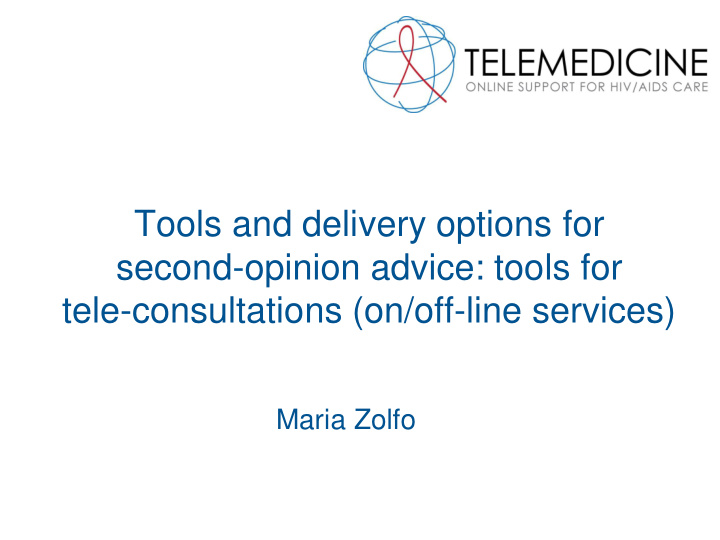



Tools and delivery options for second-opinion advice: tools for tele-consultations (on/off-line services) Maria Zolfo
History • Smoke signals • In early 1900s, in Australia two-way radios (bicycle dynamo) to communicate with the Royal Flying Doctor Service of Australia • To transmit basic clinical information: e.g. in 1948 X-ray images were sent between New York and Pennsylvania through telephone lines (Viegas, 1998) • Interactive video for telemedicine: 1964, use of a two- way closed circuit television system - Nebraska Psychiatric Institute & Norfolk Hospital with the University of Nebraska (Wittson and Benschoter, 1972)
Definition - There is no generally accepted definition of telemedicine - The literal meaning is ‘health at a distance’ Thus, telemedicine may represent health care practised in real time, using a video or asynchronously by email - It can be used for: diagnosis, management, education – of staff, patients and the general population – and for administrative meetings, … R. Wootton, RMS Press 2009
Types of telemedicine • Real-time telemedicine, synchronous (all parties being able to interact at once) • Store-and-forward telemedicine, asynchronous (information stored in some format = pre-recorded)
Types of telemedicine, cont • The interaction between patient and physician – Pre-recorded (store-and-forward): tele-radiology – Real time (synchronous): tele-psychiatry • Type of information being transmitted – Text, audio, still images, video pictures, sound • Types of communication technology; fixed lines (telephone, internet), mobile telephony, satellite, ... -> ensure that we are talking about the same
Advantages of types of telemedicine Real-time Store-and-forward More convenient – no need for Immediate result. Also the simultaneous meetings to be specialist can ask any missing arranged information immediately Low-bandwidth interaction – Meets consumer expectations – patients like the 3-way cheaper telecommunications; cheaper equipment consultations Educational benefit Educational benefit
Wide range of services • Clinical services (diagnostics, e.g. tele- pathology, tele-surgery, ...) • Expert consultations/ 2 nd opinion (between professionals) • Tele-monitoring • Communication/Interaction between different levels in the health care system (also patients) • Health information/ prevention • Peer support
Data transfer Obstetrician Soon-to-be mother and midwife
Transmitting ultrasound
Tele- ophtalmology Specialist Patient and assistant
Tele- dermatology Specialist GP/nurse and patient
Monitoring blood glucose levels • Child with type 1 diabetes and parent • Sensor + mobile Blood sugar telephone data • Automatic data transfer SMS to parent
Camera that can send video images to other departments or hospitals Headset and Virtual screen dumps microphone Electronic stethoscope that loads the result directly into the Telemedisinsk avdeling computer Wearable computer connected Personal digital assistant to the wireless network. Small computer with Smaller versions can be wireless network access sown into the clothing Nametag that can include an electronic ID that GPS (primarily for General activates sensors in practitioners) the patients room
Second opinion-advice, examples • Partners Healthcare, Boston, USA • iPath Association, Basel, Switzerland • Swinfen Charitable Trust, UK • Réseau Afrique Francophone de Télémédecine (RAFT), Geneva, Switzerland
http://telemedicine.itg.be
Interactive sites, 2009
Benefit Cases/year 200 183 180 164 159 151 149 146 160 140 120 100 80 60 40 20 0 1st year 2nd year 3rd year 4th year 5th year 6th year (+SHCH) Forum Faculty
6 years ( n : 952 referrals)
Cases/questions distribution 60 50 2003-04 2004-05 40 2005-06 30 2006-07 20 2007-08 2008-09 10 0
HON code http://www.hon.ch/ 1. Authoritative 2. Complementarity 3. Privacy 4. Attribution 5. Justifiability 6. Transparency 7. Financial disclosure 8. Advertising policy
How to organizing a telemedicine service?
7 key questions 1. What is the clinical problem to be solved? 2. What is the background ? 3. What organizational changes will be required? 4. What is the right telemedicine technique to be used (real time or prerecorded)? 5. Who will be responsible for training, support and evaluation ? 6. What is the minimum quality equipment required? 7. What technology is required?
Principles for success (according to Yellowlees PM, JTT 2005) • Select applications and sites pragmatically • Clinicians and users must own the system • Follow proven-practice principles • User-friendly technology • Training and support • Evaluation and sustainability • Share the information
Why physicians fail to accept new information systems (Treister NW, Phys Exec, 1988)
Why isn’t demand escalating? • Free telemedicine service not valued? • Cultural problem? • Digital divide • Computer literacy • Inappropriate experts? • Intuitive/user friendly • Referrers too busy? interphase • Perceived loss of control?
Evaluation?
Outcome measures 1. User satisfaction (physicians, patients) 2. Medical outcome (morbidity, mortality) 3. Financial measures (cost benefit)
Users' satisfaction (387 questionnaires, June 2006 and December 2008)
19% response rate (73/387) 43 non w ebsite users: answ ered 271 non w ebsite users: not answ ered w ebsite users: answ ered w ebsite users: not ansew erd 36 37 271 + 36 non-users 43 + 37 users
Performance metrics in teleconsultation networks
Go on line and register to the discussion forum: http://telemedicine.itg.be
CME Annual CME program certificate
Why CME? Computer-based is sexy
CME, archive 2009
Ahhhh ... ANOTHER CME!!!!
Build CME modules to mimic real situations …
How to build a CME: 3 essential questions 1. Learning objectives (make the CME relevant to the learner) 2. Help the learner understand how he will use the information 3. Use a way for the learner to prove they understand it
Right people into your eLearning project … • Project manager • Content expert • Instructional designer • Graphic designer • Flash programmer • Courseware developer • LMS expert • IT support
CME, archive 2010
Google Analytics
CME certification
Acknowledgements Thank you! The Telemedicine project is supported by the Belgian Directory General of Development Cooperation (DGDC)
Recommend
More recommend